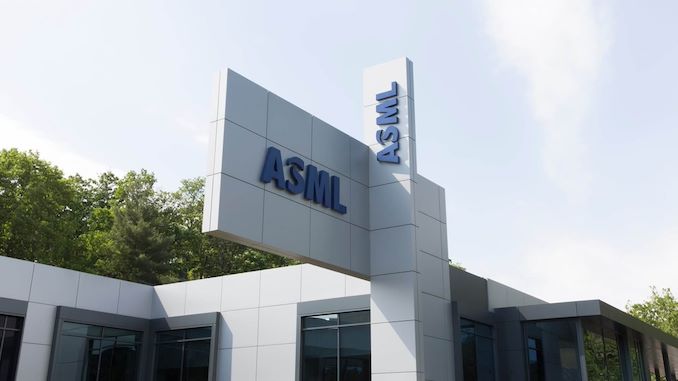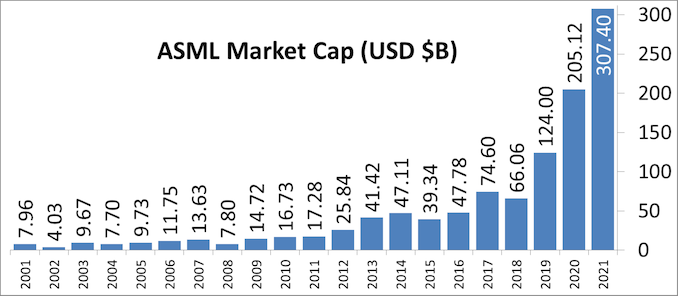Intel's Process Roadmap to 2025: with 4nm, 3nm, 20A and 18A?!
by Dr. Ian Cutress on July 26, 2021 5:00 PM ESTSidebar on Intel EUV
In all of these announcements, one thing to highlight is Intel mentioning its relationship with ASML, the sole company that manufactures the EUV machines powering production of leading edge semiconductor manufacturing.
ASML is a unique company in that it is the only one that can produce these machines, because the technology behind them is often tied up with its partners and research, but also because all the major silicon manufacturers are heavily invested in ASML. For any other company to compete against ASML would require building a separate network of expertise, a decade of innovation and design, and a lot of capital. None of the major silicon vendors want to disturb this balance and go off on their own, lest it shuts them out of the latest manufacturing technology, and no research fund sees competing against the embedded norm as a viable opportunity. This means that anyone wanting EUV specialist technology has to go to ASML.
In 2012, it was reported that Intel, Samsung, and TSMC all invested in ASML. This was, at the time, to jumpstart EUV development along with migrating from 300mm wafers to 450mm wafers. While we haven’t moved to 450mm wafers yet (and there are doubts we will any time in the next decade), EUV is now here. Intel’s 2012 investment of $2.1 billion gave them a 10% stake in ASML, with Intel stating that it would continue investing up to a 25% stack. Those stakes are now below the 5% reporting threshold, but all three of the major foundry customers are still big owners, especially as ASML’s market cap has risen from $24 Billion in 2012 to $268 Billion in 2021 (surpassing Intel).
As major investors but also ASML’s customers, the race has been on for these foundries to acquire enough EUV machines to meet demand. TSMC reported in August 2020 that it has 50% of all EUV machines manufactured at ASML for its leading edge processes. Intel is a little behind, especially as none of Intel’s products in the market yet use any EUV. EUV will only intercept Intel’s portfolio with its new Intel 4 process, where it will be used extensively, mostly on the BEOL. But Intel still has to order machines when they need them, especially as there are reports that ASML currently has backorders of 50 EUV machines. In 2021, ASML is expected to manufacture around 45-50 machines, and 50-60 in 2022. The exact number of machines Intel has right now, or has ordered from ASML, is unknown. It is expected that each one has a ~$150m price tag, and can take 4-6 months to install.
With all that being said, Intel’s discussion point today is that it will be the lead customer for ASML’s next generation EUV technology known as High-NA EUV. NA in this context relates to the ‘numerical aperture’ of the EUV machine, or to put simply, how wide you can make the EUV beam inside the machine before it hits the wafer. The wider the beam before you hit the wafer, the more intense it can be when it hits the wafer, which increases how accurately the lines are printed. Normally in lithography to get better printed lines, we move from single patterning to double patterning (or quad patterning) to get that effect, which decreases yield. The move to High-NA would mean that the ecosystem can stay on single patterning for longer, which some have quoted as allowing the industry to ‘stay aligned with Moore’s Law longer’.
| ASML's EUV Shipments | |||||||||||||||||||||
| 2015 | 2016 | 2017 | 2018 | 2019 | 2020 | 2021 | |||||||||||||||
| Actual | 2 | 4 | 10 | 3 | 4 | 5 | 6 | 4 | 7 | 7 | 8 | 4 | 7 | 14 | 8 | 7 | 9 | - | - | ||
| Target (Total) | - | - | - | 20 (18) | 30 (26) | 35 (33) | 45-50 | ||||||||||||||
| 2018 and beyond is split per quarter for actual shipped numbers Data taken from ASML's Financial Reports |
|||||||||||||||||||||
Current EUV systems are NA 0.33, while the new systems are NA 0.55. ASML’s latest update suggests that it expects customers to be using High-NA for production in 2025/2026, which means that Intel is likely going to be getting the first machine (ASML NXE:5000 we think) in mid-2024. Exactly how many High-NA machines ASML intends to produce in that time frame is unknown, as if they flood the market, having the first won’t be a big win. However if there is a slow High-NA ramp, it will be up to Intel to capitalize on its advantage.













326 Comments
View All Comments
GeoffreyA - Wednesday, August 4, 2021 - link
Android and iOS have grown towards each other over time. Today, it looks like iOS in many ways and is a lot more polished. Things have certainly changed. Going from Lollipop to Pie in 2019 was quite a departure for me but I got used to it after a few days. My Android experience (always Samsung) has been pleasant all the way, and I don't think I'll ever go onto Apple, though I hand to Tim, Craig, and the gang for their polish and their conservative addition approach vs. Android's curtailing the open doors.GeoffreyA - Wednesday, August 4, 2021 - link
I think for many people, the mobile brand and OS square with who they are, so to speak. For my part, I'd feel pretty odd using an iPhone, despite the excellent hardware. Quite likely, it's just the whole Apple atmoshere that I've got an aversion to. They'll have to send me to Room 101 if they want to convert me.mode_13h - Thursday, August 5, 2021 - link
> I'd feel pretty odd using an iPhoneApple lost me at walled garden.
I really wanted Mozilla to succeed with their Firefox OS phone project. I wish they'd stuck with it a bit longer. If they'd gotten it on another generation of phones, I was going to buy one.
I know a dyed-in-the-wool Windows user & developer who tried to stick with their phone platform, but even he got burned too many times and eventually jumped ship. If they ever had any hope of competing with Android, they couldn't afford so many strategic blunders. Also, they really just needed to copy the open source model, or at least not try to make a profit on the OS.
GeoffreyA - Thursday, August 5, 2021 - link
Let's hope they keep developing Gecko and Quantum and don't go over to Blink. I will sigh the day that happens, being a Firefox user.mode_13h - Friday, August 6, 2021 - link
> Let's hope they keep developing Gecko and Quantum and don't go over to Blink.I don't follow their developments that closely, but I know I had to disable Proton when it got switched on. It was too resource intensive and bogged down the browsing experience considerably.
GeoffreyA - Friday, August 6, 2021 - link
Me too! I disabled Proton on the first/second day. Those floating tabs were terrible.GeoffreyA - Sunday, August 15, 2021 - link
Unfortunately, 91 has made it harder to disable Proton. Wonderful.Oxford Guy - Wednesday, August 11, 2021 - link
‘I really wanted Google to succeed with their Firefox OS phone project.’Fixed it for you. Guess who runs Mozilla?
Just take a look at how many entries Google gets in about:config
mode_13h - Thursday, August 12, 2021 - link
> Fixed it for you. Guess who runs Mozilla?No, why do you say that? And why would Google get Mozilla to make a phone OS that's a competitor to Android?
> Just take a look at how many entries Google gets in about:config
That's proof of what, exactly? With one exception, they're 'browser.safebrowsing.provider.google'. If you have better providers, I'll bet Mozilla would like to hear about it.
Wow, you're like one of these conspiracy theory nuts that finds a spelling error in some random document and uses it as if it's iron clad proof of some vast, sweeping scheme.
Before Google had their Chrome browser, they were indeed a big backer of Mozilla. However, those days are long gone. Mozilla had big layoffs about a year ago, unfortunately.
Oxford Guy - Tuesday, August 3, 2021 - link
‘You're still making a pretty solid argument in favour of most Apple owners not buying due to specs.’I have met a good number of intelligent people who quit buying MtG cards long ago. Sometimes people need to learn the hard way to not feed a bad deal.
Then, there are wealthy lazy people, who I have also seen, who will fork over the blood money to Apple. In their defense, many of them are quite old and don’t want to learn new tricks — even though UI is changing anyway, mainly due to the penchant of corporations for having only contempt for the productivity and happiness of customers.